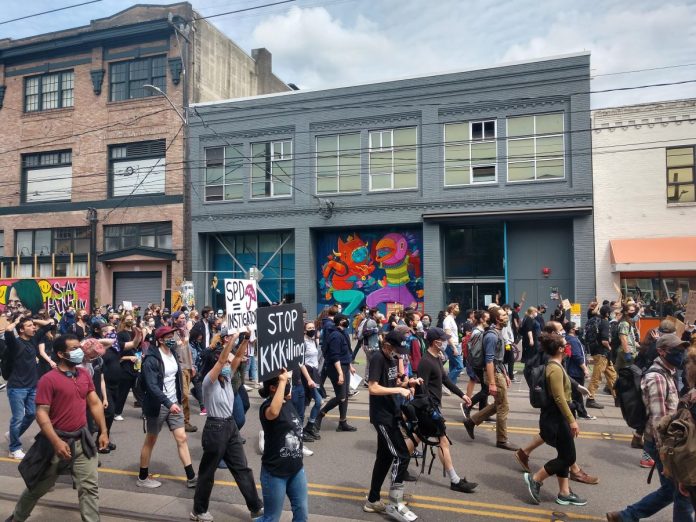The Seattle Police Department (SPD) repeatedly tear-gassed and pepper-sprayed crowds during the first two weeks of protests, but the Seattle City Council sought to close the door on this tactic yesterday. Councilmember Kshama Sawant’s bill banning tear gas, pepper spray, and blast balls passed unanimously, as did her bill banning police from using chokehold techniques.
As an emergency ordinance, the bills do need Mayor Jenny Durkan’s signature to become law. However, given her own not-so-effective attempt at a 30-day ban on tear gas and mounting public pressure, it seems likely she will sign them and they would go into effect in late July. Since George Floyd was murdered on May 25th, Black Lives Matter protests have been a continuous wave ever since, as have violent police crackdowns.
In her statement, Councilmember Sawant gave the credit to the protesters for the chemical weapons ban, which she said was first-in-the-nation legislation.
“Our victory today was not a result of enlightenment by the political establishment, but because of the thousands of ordinary people–led by young people, especially young people of color–who have marched in the streets (facing down horrific police violence), organized, spoken up at City Council meetings, and fought for systemic change,” Sawant said. “Our mass protest movement deserves all the credit for winning Seattle’s historic ban on chemical weapons and chokeholds. If in the last few weeks you marched, rallied, organized, testified, or otherwise fought for Black Lives Matter and against police violence, then today’s victory is your victory.”
At the same time, Councilmember Sawant said the ban was just the first step and reaffirmed her commitment to cutting SPD’s budget in half. All Seattle City Councilmembers have expressed interest in trimming SPD’s budget, but most have not specifically committed to a 50% cut.
“This year, the Seattle Police Department budget is a staggering $409 million–fully 27% of the city’s discretionary spending. I was the only councilmember last fall to vote against this appalling budget decision,” Councilmember Sawant said in a statement. “My office has begun discussions with community activists, organizers, affordable housing developers, young Black and brown leaders, clergy, and others around cutting the police budget by at least 50%. In the next two weeks, my office will be fighting alongside the movement to bring forward our legislation to defund the police by at least 50%.” [Emphasis hers.]
Councilmember Sawant has sharply criticized Councilmember Lisa Herbold for attempting to water down her legislation and delay it a week. One Herbold amendment would have allowed “less lethal” weapons like pepper spray in non-crowd control or free speech situations, arguing the unintended consequence might be police using more lethal weapons. Sawant called the amendment “racist” and a betrayal since it would “create giant, truck-sized loopholes that will allow these weapons to be used in virtually any situation.”
A federal judge did grant an injunction on the use of tear gas, rubber bullets, pepper spray, blast balls, and chokeholds on June 12th that will be in effect through September. Councilmember Herbold suggested that meant they had time to finetune, but that order included significant loopholes, since it was tailored to crowd control situations and included exemptions for where the officers lives are at stake or when the police chief deems other measures ineffective.
Councilmember Herbold withdrew her loophole amendment and her effort to push back the vote by a week to allow the Seattle Office of Police Accountability (OPA) and the Office of Inspector General (OIG) to weigh in–which she said was at their request. One Herbold amendment did pass, though, instructing the OPA, OIG, and Community Policing Commission to make formal recommendations by August 15th on “less lethal” crowd control tactics. That could open the door for some “less lethal” techniques to be introduced in certain circumstances.
And of course, it’s also possible police officers will ignore the ban or that the Seattle Police Officers Guild will seek to retract or weaken the ban during contract negotiations.
Violence has decreased since SPD abandoned its East Precinct barricades and allowed protesters to establish their own zone of control around the police station. Also called the Capitol Hill Autonomous Zone (CHAZ), the Capitol Hill Organized (or Occupied) Protest (CHOP) has consumed six or so blocks extending from Cal Anderson Park, with the area now filled with street art, aid stations, memorials, tents, gardens, and a stage that hosts Black leaders giving speeches about liberation and police abolition. Protesters repurposed police barricades to limit car access and protect the people inside the zone. On Tuesday, the Seattle Department of Transportation upgraded the barriers to improve safety at the CHOP.
Protesters are in the crosshairs in a lot of ways, but it’s good to see some weapons and methods of harm being taken away. Plenty of work remains.
Doug Trumm is publisher of The Urbanist. An Urbanist writer since 2015, he dreams of pedestrian streets, bus lanes, and a mass-timber building spree to end our housing crisis. He graduated from the Evans School of Public Policy and Governance at the University of Washington in 2019. He lives in Seattle's Fremont neighborhood and loves to explore the city by foot and by bike.


